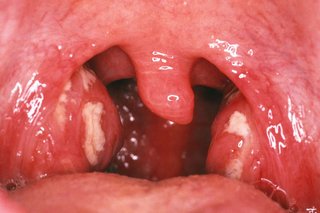Experiences with
TonsillitisCheck if you have tonsillitis
Tonsillitis can feel like a bad cold or flu. The tonsils at the sides of your throat will be red and swollen.
Symptoms in children and adults can include:
- a sore throat
- problems swallowing
- a high temperature
- coughing
- a headache
- feeling and being sick
- earache
- feeling tired
Sometimes the symptoms can be more severe and include:
- swollen, painful glands in your neck (feels like a lump on the side of your neck)
- pus-filled spots or white patches on your tonsils
- bad breath

How to treat tonsillitis yourself
Tonsillitis usually gets better on its own after a few days but it can last longer.
To help treat the symptoms:
- get plenty of rest
- drink cool drinks to soothe the throat
- take paracetamol or ibuprofen (do not give aspirin to children under 16)
- gargle with warm salty water (children should not do this)
- Mix half a teaspoon of salt in a glass of warm water and stir until it has dissolved.
- Gargle with the salty water (do not swallow it), then spit it out.
- Repeat as often as you like.
Young children should not gargle with salty water.
Speak to a pharmacist about tonsillitis.
They can give advice and suggest treatments, like:
- lozenges containing a local anaesthetic, antiseptic, or anti-inflammatory medicine
- throat sprays (although there's little proof they help)
- antiseptic solutions
- the symptoms of tonsillitis do not go away within 1 week
- you keep getting throat infections
- you have pus-filled spots on your tonsils
- you have a sore throat so painful it's difficult to eat or drink
You can call 111 or get help from 111 online .
What happens at your GP appointment
A doctor can usually tell if it's tonsillitis by asking about your symptoms and looking in your throat.
You may also need:
- a swab test to see if bacteria are causing your tonsillitis (a cotton bud is used to wipe the back of your throat)
- a blood test for glandular fever if symptoms are severe or will not go away
Treatment from a GP for tonsillitis
Treatment for tonsillitis will depend on what's causing it:
- most children and adults get viral tonsillitis (caused by a virus), which clears up on its own
- for bacterial tonsillitis (caused by bacteria), a GP may prescribe antibiotics
A GP will usually wait for the test results to tell which type you have.
It's very rare that someone needs to have their tonsils taken out.
This is usually only done if you have severe tonsillitis that keeps coming back.
Causes of tonsillitis
Tonsillitis is usually caused by a virus, such as a cold, but it can also be due to a bacterial infection such as strep throat.
Complications of tonsillitis (quinsy)
Complications of tonsillitis are very rare.
Sometimes you can get an area filled with pus (abscess) between your tonsils and the wall of your throat. This is called quinsy.
- you have a severe sore throat that quickly gets worse
- you have swelling inside the mouth and throat
- you have difficulty speaking
- you cannot swallow
- you have difficulty breathing
- you have difficulty opening your mouth
These are signs of quinsy.
Do not drive to A&E. Ask someone to drive you or call 999 and ask for an ambulance.
Bring any medicines you take with you.
SymptomsSelf-careMedical treatmentsCausesSymptoms of tonsillitis include red, swollen tonsils, a sore throat and difficulty swallowing.
To help symptoms of tonsillitis, you can take paracetamol or ibuprofen, get plenty of rest and gargle with warm, salty water.
Treatment for tonsillitis depends on what caused it. A GP may prescribe antibiotics if it's caused by bacteria.
Tonsillitis is usually caused by a virus, but it can also be due to a bacterial infection.
Related links

HealthUnlocked contains information from NHS Digital, licensed under the current version of the Open Government Licence